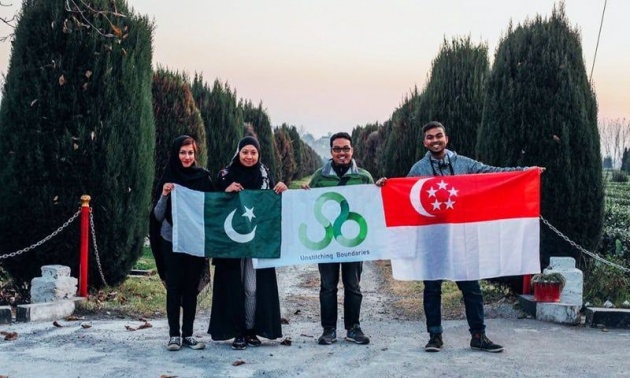In 2013, I went with my family to Bedadi — a small village in Khyber Pakhtunkhwa's Mansehra district. Amidst the endless cups of chai and overwhelming hospitality, I noticed the blinding darkness that engulfed the village as soon as the sun set. This darkness would bring a sudden end to life here — it was discomfiting.
Back in Singapore, where I live, I had been active with a group called "happy people, helping people" on Facebook. We helped out cardboard collectors in Singapore and others in need in Southeast Asia. I, therefore, had some skill and resources that helped me decide my next project for Bedadi: "Light and Life".
Over the course of the next two years, I began hunting for fundraising opportunities and suitable sources of light. I met Firdaus Marzuki and his wife Nur Hidayu Mas'od through an event that we hosted for needy people in Singapore, courtesy of the aforesaid Facebook group. Firdaus and Hidayu indicated their interest in exploring Pakistan's rich culture. It was the perfect chance encounter because I was planning a trip there as well, we immediately became a trio.
Later, I met Siraj Aziz through a fundraising event for Rohingya refugees. He had generated funds for the victims of the 2010 super floods in Pakistan. I proposed the project to him, he agreed and soon our trio became a foursome. Subsequently, 'Unstitching Boundaries' was conceived.
The team behind Unstitching Boundaries.
We researched 'portable lights' on the Internet and stumbled acrossLuminAID Solar Lights. Founders Anna Stork and Andrea Sreshta had an inspiring back story. They were asked to design a product to facilitate earthquake relief efforts in Haiti, the duo saw a need for lights in an emergency situation and consequently, LuminAID was born.
The light itself is very bright — 65 lumens — and can last for two years. To its credit, it is portable and waterproof and collectively these features made it the perfect device for Bedadi's villagers for their daily use and also in the event of natural disasters.
As far as funds were concerned, it was an uphill task in the beginning. We started in mid-2015 with a small flea market at the Straits Records in Singapore. Our sale of baked goods and used clothing raked in a few hundred dollars.
An Indiegogo (a global site for fundraisers) page followed suit and piqued interest on both online and offline social media platforms. By late 2015, the interest had peaked to an all-time high, with donations coming in from Indiegogo, as well as through word-of-mouth from friends, families and incredibly kind strangers.
By Dec 4, 2015, we had raised a total of USD$ 3292.80. We were so close to our goal of SGD$5000 for 300 lights. But the money we had at that time was only enough for 258 lights. They say help comes from the most unexpected places, and rightly so.
The wonderful people at LuminAID added an additional 30 lights (free of charge) to round off the boxes which brought it to a total of 288 lights!
We set aside two kilos of rice to be given away with each light.
Beautiful children who visited in the hopes of receiving lights and rice for their families.
But it didn't just stop there: donations kept pouring in even until the day we flew out.
Before pursuing projects in remote villages, we normally identify some contacts. My family proved to be a tremendous help in laying the groundwork, and sourcing reliable contacts in Pakistan.
With an excellent team of volunteers and a worthy cause ahead of us, we set off for Bedadi with lights in our hands and hearts.
Initially, communicating with the villagers was a little difficult as most of them only understood and spoke in Pashto. But thanks to our volunteer translators, we managed to overcome the barrier with much ease, picking up some stray words of Urdu and Pashto along the way.
During distribution, curious children formed a trail of intrigue and smiles.
There was also the issue of rough terrain. We had to cross streams and uneven ground of all inclinations to get to some of the houses. This took up a lot of time and with news of the solar lights spreading across the village, we were soon inundated with villagers crowding around our vans and requesting for more lights.
Watching the lights being used merely hours after distribution brought a smile to our faces.
Within two days, we had run out of lights but we still had villagers waiting outside for more. It was heartbreaking but also strengthened our resolve to take on more projects that would not just be limited to solar lights but also domestic and sanitation issues faced by these villagers.
A village girl holding a LuminAID light.
I still remember how, on our way back, we stopped our van and rushed to the nearby houses. Our hearts soared at the sight of the solar lights being charged on the zinc roofs of the attap houses. It was an incredible experience.
Watching the lights being used merely hours after distribution brought a smile to our faces.
When we were not being stuffed with Pakistani goodies and chai, we toiled at packaging rice, distributing lights in our cars and on foot. Every step of the way, we were assisted by friendly locals.
With the 288 solar lights in Bedadi, I don't hope for a very large change to come about for the villagers. I do, however, hope that at least some of them will not feel utterly incapacitated in the dark anymore, that they will have light and life despite the darkness.



